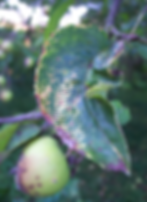TREES, PLEASE! Viruses, Variegation & Genetic Mutation
- k-england
- Feb 1, 2021
- 3 min read
Updated: Mar 1, 2021
By Robin Y Rivet.

Orchid tree with rare variegation - Bauhinia spp.
The coronavirus is on everyone’s mind. COVID-19 has caused extreme loss of life - but few people understand what a virus is - and what it is not. Essentially a piece of genetic material encapsulated with a protein coat, viruses latch onto living things. If you place a virus on an inert surface, it doesn’t do much; it just sits there. The only way a virus “propagates” itself, is if it invades a host - such as a plant, animal or person.
Can plants catch a virus from us? Yes. Tobacco mosaic virus is a commonly recognized example. If you smoke cigarettes, the virus may transfer from your fingers to your tomatoes. Although the result of exposure can be devastating, there are times when viral infections are revered for their interesting outcomes.
What if you crave a tree with desirable traits like “mosaic” foliage? Colorful leaf variegations are often the result of viral infections, but similar characteristics can occur from spontaneous genetic “errors”. If desirable, the latter may be vegetatively propagated to ensure the genetic “mistake” is revealed in progeny, but those mutants are rarely capable to regrow from seed. However, unlike viral-caused distortion, appealing genetic mutations have a long history of intense propagation - since colorful and extraordinary leafy forms often add intrigue to landscape trees. Although they grow poorly in our climate, Japanese maples are a prime example. Light-colored foliage brightens shadowy garden spaces. The pictured orchid tree with speckled leaves is rare, but species like Duranta repens ‘Variegata’, Acer negundo ‘Variegatum’ and many colorful Ficus and holly tree species are readily available at local nurseries.

Camellias exhibit some of the most ornamental characteristics from both viral-caused variegation and genetic variation, and their blotchy effects can turn up not only on leaves, but also inflorescence. Horticulturists have taken advantage of these “accidents”, and sometimes deliberately introduce yellow mottle virus into camellia cultivars. The appealing effects will vary, but viruses still retard vigor, and remain with plants for life. Abutilonis another species with attractive virus-linked variegations, as are dogwoods. The mosaic quality in abutilon is naturally transmitted by the silverleaf whitefly, but it can also spread through contaminated tools and asexually propagated material.

A few viruses cause severe diseases in fruit orchards. Citrus tristeza virus is well known as a debilitating ailment, but it is typically avoidable by not grafting stock from unknown sources, although aphids can still spread it. Cultural practices go a long way toward prevention. Apple and cherry viruses also exhibit foliar dis-coloration, but are linked to reduced fruit production – never a virtue for edible crops. Shortages of chlorophyll in most species translate into a decreased ability to photosynthesize, hence making weaker plants; although succulents seem to defy that premise.

An interesting citrus cultivar, and one especially suited for planting in containers is the Pink Lemonade tree. It was discovered as a sport of a Eureka lemon. It has colorful cream and green variegated leaves, yellow and chartreuse striped rind, and lycopene-rich, pink flesh. It is not viral-induced but was a spontaneous genetic mutation. Their naturally diminutive stature makes them well-suited for home gardens.
A good reminder is that most harmful diseases of trees are caused by fungi or bacteria - not viruses. In practice however, we should never knowingly plant or introduce virus-infected stock into our landscapes. When grafting, certified virus-free scion is vital, and we all should be vigilant in removing and disposing of plants that exhibit disease symptoms.
Unless of course you crave exotic camellias…

